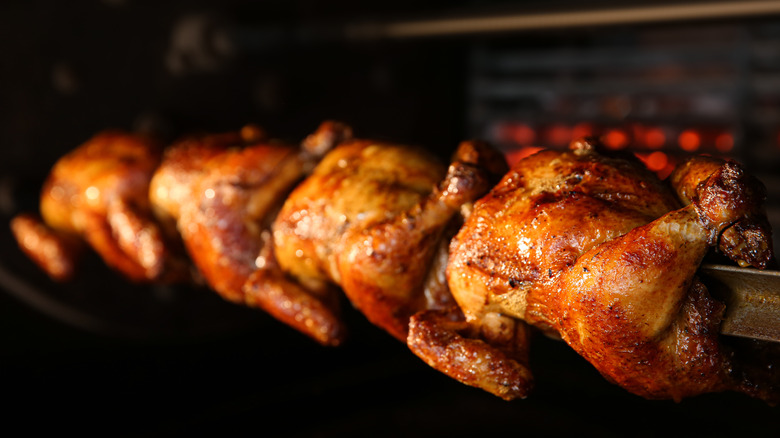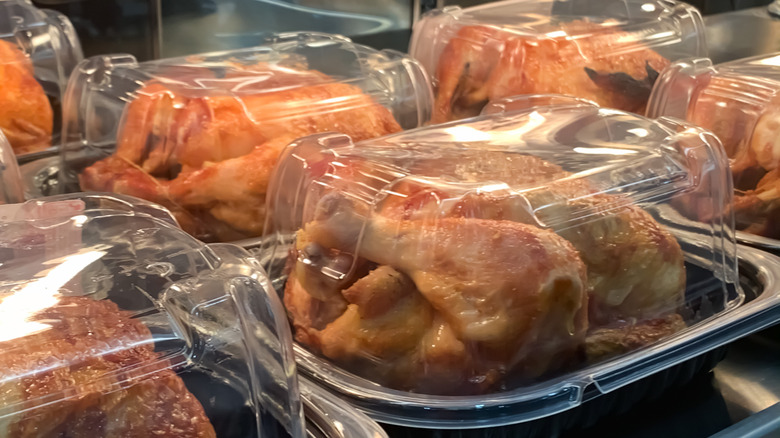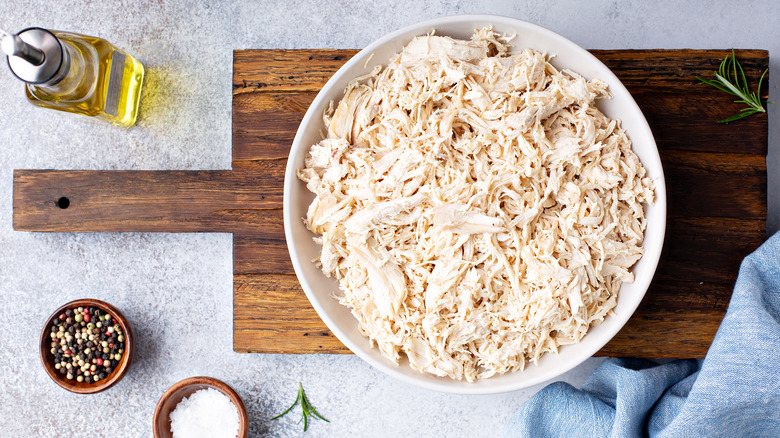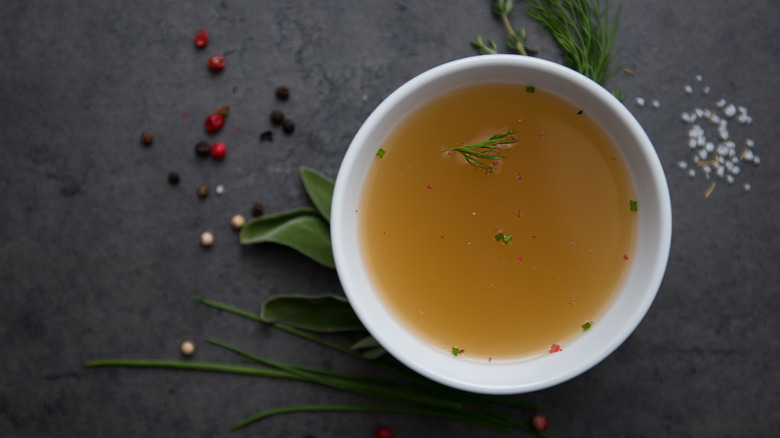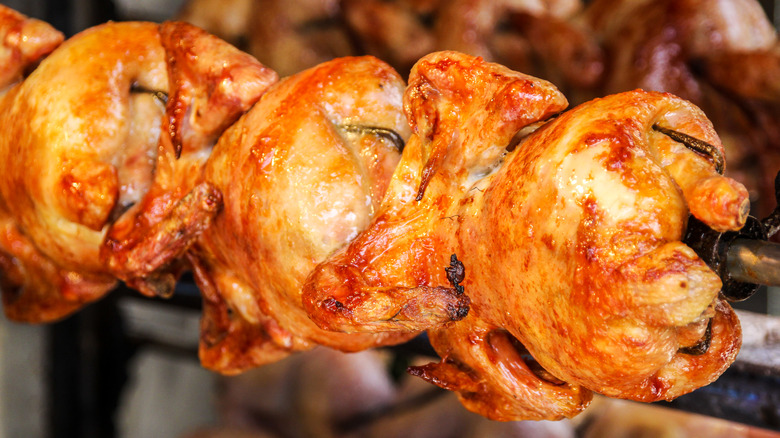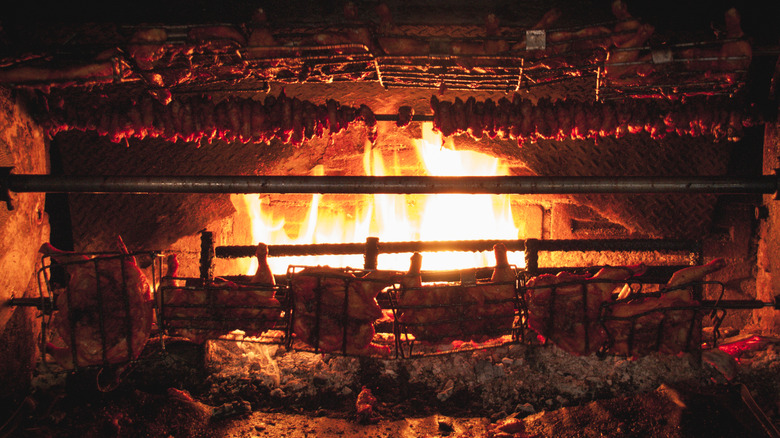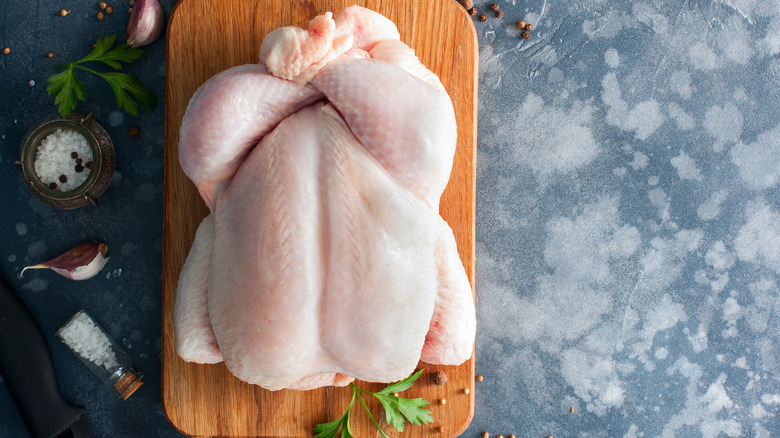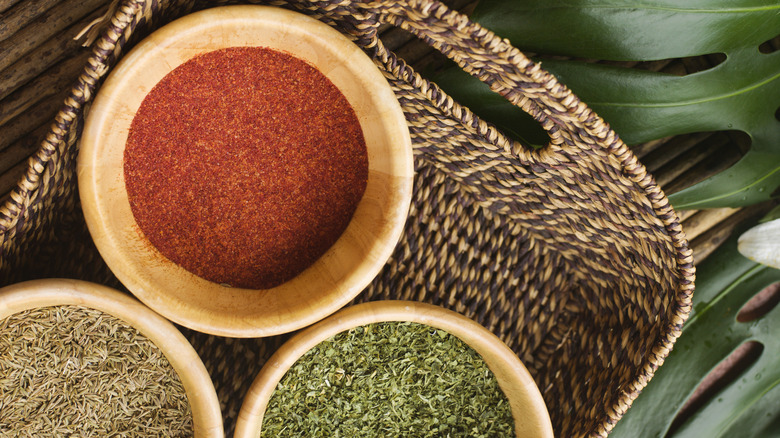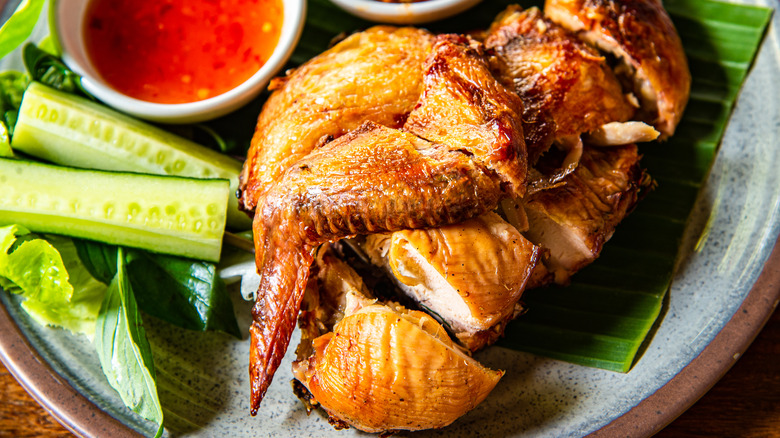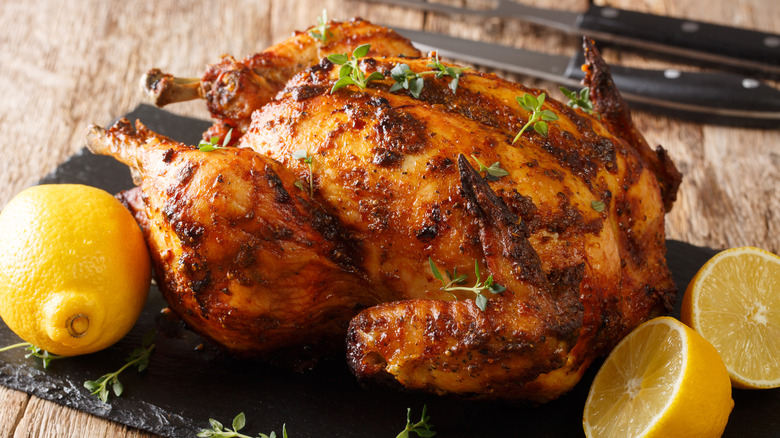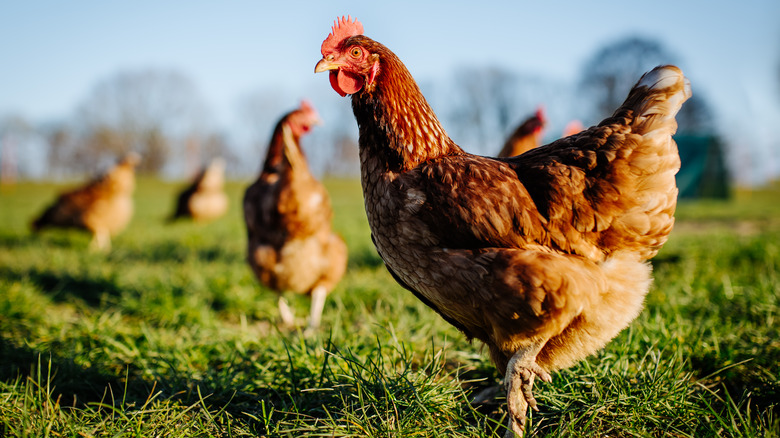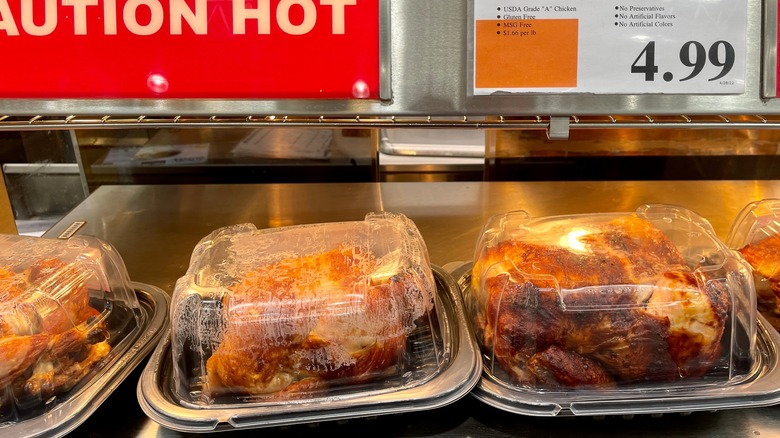Rotisserie Chicken Myths You Can Stop Believing
As a quick fix for an easy-peasy weeknight dinner, rotisserie chicken is both an effortless solution and a succulent meal on its own or with vegetable or grain-based sides. It hits all of the critical marks: tenderness because the fat has the opportunity to soak with the meat while rotating on a spit, crispiness and savory notes from the seasoned skin, and of course, unmatched caramelization.
Starting with Boston Market's introduction of the perfect to-go meal in the early 1990s, the rotisserie chicken craze surged through the roof and continues to be a home staple for families across the U.S., according to The Hustle. By 1994, other grocery stores like Costco and Kroger also became known spots to find rotisserie chicken in a pinch. In fact, Costco is still a top-seller of the product, and famously so.
Sometimes, a readymade hot meal is the answer when cooking is out of the question. However, from proper storing methods to maintaining its unique juiciness, there are a few factors about this classic dish you may have to reconsider entirely. Here are the rotisserie chicken myths you can stop believing.
You can't freeze a rotisserie chicken
The first rotisserie chicken myth you can stop believing pertains to keeping it fresh. Just because it comes cooked, it doesn't mean it can't have a long-lasting shelf life. When you buy a rotisserie chicken, it should be consumed within two hours or refrigerated within that same time frame, but there's another option on the table if you're looking to make it stretch: Freeze it.
The U.S. Department of Agriculture (USDA) claims that a whole rotisserie chicken lasts up to four months in the freezer and no longer — that is if flavor and quality are important to you. Wrapping and storing it in an airtight container is key to maintaining freshness, and cutting it into several halves can also ensure that its tender texture remains intact. As for thawing rotisserie chicken, transfer it to the fridge up to two days in advance for a quick and easy hands-off method. Next time you're wondering what to do with those rotisserie chicken leftovers, pop them in the freezer and you'll be set for another meal.
You can only shred a rotisserie chicken when it's cold
We get it. It seems commonsensical that you should wait until your rotisserie chicken is completely cool before you begin shredding it into pieces and storing them in the fridge for leftovers. Whether you're shredding by hand or using a stand mixer on low, it would seem obvious that cold chicken is ideal. In fact, it's actually more effective to break chicken into pieces while it's still warm, according to Fed and Fit. The answer simply lies in food science.
White chicken meat contains plenty of muscle fibers, which are more loosely bound when hot rather than cold, making it less challenging to shred. It's a lot simpler to successfully shred chicken when the fibrous pieces pull apart seamlessly, and it makes for a less stringy piece of chicken. Warm chicken is also easier to work with because unlike its cold counterpart, it isn't as tough in texture and still contains moisture. So next time you're looking to repurpose your rotisserie chicken leftovers for a chicken noodle soup or to incorporate them into a creamy pasta dish, remember that you won't have to wait an eternity for the bird to cool.
Reheating a rotisserie chicken will make it dry
It's natural to want your leftover rotisserie chicken to have the same juiciness as when you first bought it. Unfortunately, it's more likely that it won't, unless you adhere to a couple of easy ways to boost your seemingly lifeless dinner. Thankfully, there are straightforward ways to reheat chicken and avoid a dry result.
Firstly, if you want to revive that once-crispy skin and moist meat, the oven is where your chicken should be. A simple step will make the key difference that guarantees juicy chicken. According to Southern Living, placing a cup of chicken broth in an oven-safe dish is an easy way to reintroduce moisture into a rotisserie chicken. Simply cover the chicken with foil and pop it in the oven with the broth. Another option is to heat the chicken in a pan with butter or oil and add a splash of chicken broth, Insider suggests. You'll barely be able to tell the difference between what you picked up at the store and what's been reheated after a stint in the refrigerator.
You can recreate a juicy rotisserie chicken in a conventional oven
While it's possible to recreate a delicious homemade rotisserie chicken using a special kit or with a rotisserie attachment on an outdoor grill, there's one conventional tool that won't help much in this area — your everyday oven. It turns out there are a few elements at play that are preventing you from achieving a plump, slightly glazed, amber-colored chicken in your home oven.
According to Smoker Grill Girl, a rotisserie at the grocery store produces direct heat that allows the chicken to develop a juicy texture as it slowly cooks. Conversely, when chicken is made in an oven, confined heated air cooks the meat (aka dry heat cooking), and this tends to dry the meat. Further caramelization from a slow cook method also creates that crispy, rotisserie chicken skin. As the chicken bastes in its own juices, moisture is locked in allowing for an even cook.
Grocery stores often brine their chickens before placing them on the rotisserie, and it isn't uncommon to use a commercial brine containing ingredients like phosphate, modified potato starch, dextrose, yeast extract, and dextrin, to name a few. As the chicken rests on heated grocery store shelves, its juices are contained, giving the meat its signature tenderness.
Rotisserie chicken is prepped the same way as you would a roast chicken
Perhaps you haven't given much thought to how the preparation of a roast chicken differs from its slow-cooked counterpart. For starters, one is cooked over an open flame for a slightly charred flavor, and the other is cooked using electric heat. While roasting a chicken is an ordinary, run-of-the-mill way of cooking the bird using a conventional oven, these two preparations yield different results in texture and taste.
Firstly, when roasting a chicken in a home oven, the juices drip downward and settle in the pan. This makes for a flavorsome juice to season sides like mashed potatoes, although the chicken can lose a bit of its punch (via Smoker Grill Girl). By cooking this bird in an oven, there's less of a chance it will cook evenly, whereas a rotisserie provides every side with an opportunity to heat due to constant spinning.
According to Cookindocs, one way to prepare a roast chicken is to coat it with oil or butter to give it sufficient moisture before it goes into the oven. However, this is not the case when prepping a rotisserie chicken, since the goal is to get a brittle crispy skin via the Maillard reaction.
All store-bought rotisserie chickens contain additives
You think you've taken all the right steps to recreate a store-bought rotisserie chicken, yet the ones at your local grocery store still run leaps ahead of the one you've tirelessly prepared. The answer? Additives are part of the reason why store rotisserie chicken tastes better, but not all grocery stores use them.
Take Costco's famous and affordable rotisserie chickens, a selling point for loyal customers. According to Consumer Reports, the grocery store injects a heavy dose of saline solution, which is mainly composed of salt but can also include sugar, gums, and carrageenan, into its cooked birds to give them a mouthwatering flavor. While the practice of adding saline solution is common in grocery stores like Sam's Club, some places are more moderate with their use of additives. BJ's Wholesale Club, Publix, and Stop & Shop typically use about half the quantity of sodium that Costco uses, according to Money Talks.
Don't let this deter you from purchasing a rotisserie chicken for dinner. Whole Foods is known for keeping its classic rotisserie chicken simple, and it contains just three ingredients: chicken, salt, and organic black pepper. Meanwhile, Wegmans also carries organic chickens with under 100 milligrams of sodium, making the grocery store a solid contender if you want to avoid excess salt and additives.
The same chickens are used for both regular cuts and rotisserie chicken
Another factor you may have been led to believe is that grocery store chickens all originate from the same type of bird. A chicken is a chicken but birds vary in size, as well as how they're raised before they end up on your dinner plate. Consumer Reports explains that rotisserie chickens are not the same animal as an ordinary uncooked chicken you find in the freezer section of a grocery store.
Rotisserie chickens are bought separately from a store's fresh whole chicken supply. This is due to their size, as smaller birds work better on a rotisserie. These are typically between 2.5 and 4.5 pounds in weight, whereas uncooked counterparts tend to start at around 5 pounds. So if you've ever thought that chickens are interchangeable, it might be one of the reasons you find it challenging to recreate a rotisserie chicken at home.
Random spices are used in rotisserie chicken
Another news flash that will make you question your rotisserie chicken beliefs comes down to the spice profile used. You're probably craving the crispy chicken due to the seasonings that contribute to its delicious flavor. Though you can find a variety of spices depending on where you buy your chicken, if you notice a consistency in flavor it might be due to the incorporation of a specific spice blend that creates the standard rotisserie flavor.
For starters, salt and pepper are necessary no matter the chicken dinner preparation, however, other common seasonings that provide a notable flavor enhancement are onion and garlic powder. McCormick for instance carries a rotisserie chicken seasoning containing salt, onion, paprika, garlic, citric acid, and other spices, which results in a classic flavor. Depending on the proportions used, these spices slightly mimic the taste of barbecue seasonings as well.
Rotisserie chickens are not cooked through if there's pigmentation near the bones
Although it is important to make sure you are consuming foods that are not past their expiration dates, some factors may be misleading. According to Eating Well, poultry is fully cooked when the meat is white in color and the juices are clear. Pink parts can indicate that the chicken is undercooked, and a raw texture is a surefire way to know that your meal could use more time cooking. Meanwhile, gray coloration could mean your dinner has been overcooked.
The occurrence of a slight, pinkish pigmentation near the rotisserie chicken's bones can lead to uncertainty. Though it may seem alarming, it shouldn't be confused with red or pinkish coloration in the meatier parts. The USDA states that this is a natural result of using a smaller chicken during preparation. At a youthful age, more pigmentation can be found near the bones due to red blood cell protein molecules. If the chicken is safely cooked, this is nothing to fear. If there is any doubt about the freshness of your poultry meat, it is always worth using your best judgment. Of course, checking that the temperature has reached a minimum of 165 F using a meat thermometer quickly alleviates any hesitations you might have.
Rotisserie chickens are expired chickens
Another common myth revolves around the expiration date of rotisserie chicken. While you may have been under the impression that grocery stores repurpose their leftover expired chickens to make their rotisseries, this is untrue. The USDA regulations for poultry sell-by dates recommend using it within one to two days of purchase. Typically, rotisserie chickens are taken off the shelf if they are not bought within a couple of hours, according to Consumer Reports.
Some grocery stores repurpose their rotisserie chickens after they've been sitting around for a few hours, notably in pre-made dishes for their hot food bars. If you're looking for the freshest option, it's customary for grocery stores to have new rotisserie chickens ready every two to four hours, from morning to early evening. Evening peak hours are an ideal time to fetch one if you're planning for the same night's dinner, and you could even try calling up your local store to see when the next batch will be ready.
Rotisserie chickens are more expensive than making your own
In some cases, making dishes from scratch will save you money, however, this is not always the case with rotisserie chicken. It's worth accounting for time and effort when assessing the cost-effectiveness of your decision.
Since they are smaller than fresh, frozen chickens, rotisserie chicken typically costs less per pound. Grocers are surprisingly at peace with losing more money than they make from selling rotisserie chickens, according to CBC. Customers are so dependent on the convenience of purchasing a pre-cooked meal, that it's actually more worthwhile for grocers to sell lower-priced rotisserie chickens to keep their consumers happy. It's also worth noting that customers will seldom leave the grocery store with just a rotisserie chicken anyway.
Another factor to consider is the volume of sales; Costco claims to have sold 106 million rotisserie chickens globally in 2021 (via CNN Business). A processing plant was even constructed alongside the business to keep up with consumer demand. The Penny Hoarder explains that once you factor in the time and labor costs of making your own chicken, you might realize purchasing a rotisserie chicken is worth it on both fronts.
Free range rotisserie chickens are a healthier choice
It turns out that a rotisserie chicken's "free range" label might be slightly misleading. Chickens deemed "free range" can sound like a healthy choice as opposed to your regular option, and there are few requirements needed for this label to be present. The USDA informs us that meat or poultry products being submitted for approval to obtain this title must come with a description of an animal's housing conditions. If these animals have access to the outdoors for a little over half of their lives, then the product is eligible to be considered "free range."
But if livestock is proved to be fed and contained for most of their growing lives, it won't pass the test. However, the National Chicken Council reminds us that as this rule stands, chickens may still choose to never go outside. Additionally, seeing a label like "farm raised" can sound exciting to a health-conscious consumer, though this information is obvious as chickens come from farms. Restaurants typically include this label when sourcing locally.
Rotisserie chickens are made in grocery stores
Here's another thing about rotisserie chicken you may have not realized: Your grocery store is not the first stop for preparation, according to Simple Most. Rotisserie chickens are delivered to grocery stores from poultry companies and therefore considered a processed food. Before they arrive, these chickens have already been seasoned and are sometimes pumped with a saline solution for brining. Grocery stores merely act as a place for them to rotate on rotisserie spits to reheat before being sold to hungry customers.
In a Reddit thread, a past grocery store deli worker points out that rotisserie chickens were delivered to them in blue plastic sacks, often in packs of six, further explaining that they were "swimming in who-knows-what kind of juice and already seasoned. We just took them out, put them on the rotisserie skewer in a big row, then let the machine do its thing." Another Reddit user, who has also worked in a grocery store, confirms this experience as "accurate," recalling the "big blue plastic sacks of Perdue chickens inside a cardboard box. dump them out in the prep sink, shove them on a skewer, and stick them in the rotisserie."
